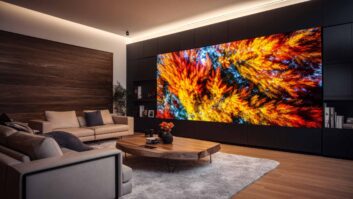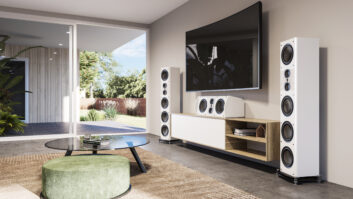Admit it, you’re addicted. You put in-wall speakers in every room. You install them in living rooms, bedrooms, kitchens, home theaters, bathrooms, decks and hallways. You are popping them in everywhere, just like light cans.
In-wall speakers launched the custom installation market, and for years have helped define it. They are an economic driving force in this industry. Big manufacturers don’t care about small installers. Smaller in-wall speaker manufacturers, however, thrive on our market. They give us great margins and are essential to our bottom lines. They consistently make our installations easy and profitable.
So why would I blather on about in-wall addiction as if we should be in a recovery group? Our industry has successfully wired and installed thousands of homes full of speakers that basically sound about as good as a dentist’s office. The result is quantity, but at lower quality.
Good speaker design depends on properly built enclosures that take bass performance, resonant frequency, bass porting and many other critical factors into the design. Speakers just need the right boxes to perform.
Because even expensive in-walls don’t have an acoustic enclosure, they can’t compare with a quality bookshelf speaker. You can find some very good sounding bookshelf speakers at around $400 a pair. They beat the pants off of similarly priced in-walls.
Before you think I’m nuts, let me rant on. There is a place for in-wall speakers. Because of their great markups, ease of installation and how non-invasive they are to decorating schemes, they are an easy go-to solution. I always use them in bathrooms and secondary bedrooms. In most other rooms and many applications, however, they are a very poor solution.
I walked through a Malibu home the other day where the proud owner showed me his new home theater system. The installers used five in-wall speakers. The left and rights were round ceiling speakers in the wrong locations, 30 feet apart. They were aimed straight down at the empty end of the room without any chance of hitting the seating. The center speaker was rectangular and located in the wall just above the TV, too low to allow a big cabinet, and again not aimed at the seating. This is a textbook failure of using in-walls improperly.
The installers who worked on this particular home should not have installed wiring and cut holes for the LCR speakers. For the same money they should have sold my friend three matched quality bookshelf speakers and placed them in the TV cabinet. The sound for music or home theater would have been far superior, the locations would have been correct and they could have been properly aimed at the couch.
My advice is to use in-walls only when there is no other choice. Be professional and creative. You can often place speakers in furniture. Look for cabinets or shelves where bookshelf speakers can be installed at about six to eight inches high. Sometimes placing speakers on top of cabinets hides them. Cabinets can often be designed with spaces for speakers behind grill cloth. While this may sound old fashioned, the difference in sound quality is well worth it. If you are savvy, then you can find some good-looking speakers with fine finishes to place on the floor that will please the toughest decorators.
Sometimes in-walls are your only choice. When I am forced to use them in important rooms like great rooms, living rooms or master bedrooms, I won’t compromise. I reach for special speakers that actually have solid speaker enclosures that fit neatly into the wall.
Triad makes a complete line of speakers with great enclosures that sound very good. They also make several in-wall subs that can be used for two-channel applications in larger rooms and quality in-wall surround speakers, all of which that have cabinets.
Most in-wall manufacturers offer optional enclosures for their standard in-wall line. Linn, Niles, Sonance, SpeakerCraft and others have enclosure solutions. Order in a load of them and right away you will notice the quality improvement. If you need to use in-wall speakers, then spend extra money on them. Your installations will always sound better as a result.







